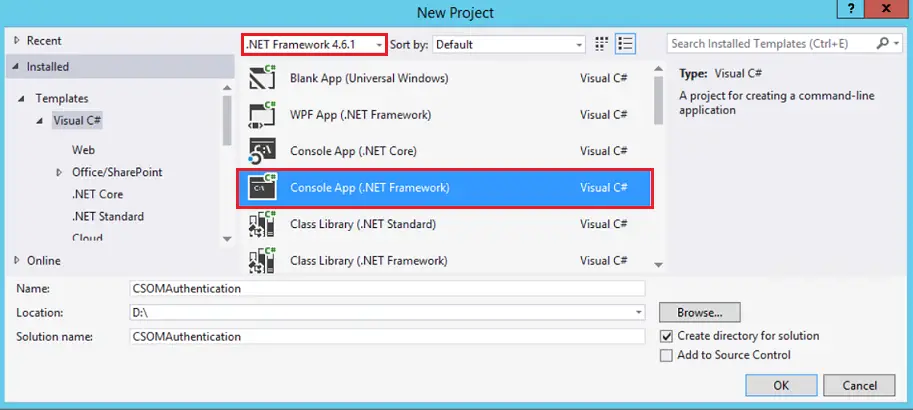In this article, we have demonstrated how you can connect to SharePoint On-premises, Online, and Extranet using C# code. We have provided easy and ready to use code that you can directly utilize in your program.
Connect to SharePoint environment using C#
Here, we have provided a single class file which takes Site URL, Username, Password, and Environment as parameters and based on these details, it authenticates the user and gives context object which can be used to access various SharePoint objects using C# code.
We have provided comments wherever is needed which makes the code self-explanatory.
You can also check some very useful operations using C# code in SharePoint which you can be utilized after the authentication method provided here.
Create Console application in Visual Studio
- Open Visual Studio. I have used Visual Studio 2017. This can also work in the older version.
- Create a New Project. I have used .Net Framework 4.6.1 and have created Console Application as shown in the screenshot below

- Below are the references added to the project.Microsoft.SharePoint.Client;Microsoft.SharePoint.Client.Runtime;
- Entire Program.cs file is copied below. You can use it as it is and your code should work.
-
using
System;
-
using
System.Linq;
-
using
System.Security;
-
using
System.Net;
-
using
Microsoft.SharePoint.Client;
-
-
namespace CSOMAuthentication
-
{
-
class
Program
-
{
-
static
void Main(string[]
args)
-
{
-
// Provide Site URL
-
string
SiteURL = "SiteURL";
-
-
// Provide the environment in which the site resides. One of the below options.
-
// (i) onpremises
(ii) o365 (iii) extranet
-
string
Environmentvalue =
"o365";
-
string
username = "UserName";
-
string
password = "Password";
-
AuthenticateUser(new
Uri(SiteURL),
Environmentvalue, username, password);
-
}
-
-
private
static
void
AuthenticateUser(Uri
TargetSiteUrl,
string Environmentvalue, string
username, string
password)
-
{
-
try
-
{
-
// Based on the
environmentvalue provided it execute the function.
-
if (string.Compare(Environmentvalue,
"onpremises",
StringComparison.OrdinalIgnoreCase)
== 0)
-
{
-
ClientContext
Context = LogOn(username, password, TargetSiteUrl);
-
// isAuthenticated
= true;
-
// You can write
additional methods here which you want to use after authentication
-
}
-
else
if (string.Compare(Environmentvalue,
"o365",
StringComparison.OrdinalIgnoreCase)
== 0)
-
{
-
ClientContext
Context = O365LogOn(username, password, TargetSiteUrl);
-
// isAuthenticated
= true;
-
// You can write
additional methods here which you want to use after authentication
-
}
-
else
if (string.Compare(Environmentvalue,
"extranet",
StringComparison.OrdinalIgnoreCase)
== 0)
-
{
-
ClientContext
Context = ExtranetLogOn(username, password, TargetSiteUrl);
-
// isAuthenticated
= true;
-
// You can write
additional methods here which you want to use after authentication
-
}
-
}
-
catch (Exception ex)
-
{
-
// log error
-
}
-
}
-
-
private
static
ClientContext
LogOn(string
userName, string
password, Uri url)
-
{
-
ClientContext
clientContext =
null;
-
ClientContext ctx;
-
try
-
{
-
clientContext = new
ClientContext(url);
-
-
// Condition to
check whether the user name is null or empty.
-
if (!string.IsNullOrEmpty(userName)
&& !string.IsNullOrEmpty(password))
-
{
-
SecureString
securestring =
new
SecureString();
-
password.ToCharArray().ToList().ForEach(s => securestring.AppendChar(s));
-
clientContext.Credentials = new
System.Net.NetworkCredential(userName, securestring);
-
clientContext.ExecuteQuery();
-
}
-
else
-
{
-
clientContext.Credentials = System.Net.CredentialCache.DefaultNetworkCredentials;
-
clientContext.ExecuteQuery();
-
}
-
-
ctx = clientContext;
-
}
-
finally
-
{
-
if
(clientContext !=
null)
-
{
-
clientContext.Dispose();
-
}
-
}
-
-
return ctx;
-
}
-
-
private
static
ClientContext
O365LogOn(string
userName, string
password, Uri url)
-
{
-
ClientContext
clientContext =
null;
-
ClientContext ctx =
null;
-
try
-
{
-
clientContext = new
ClientContext(url);
-
-
// Condition to
check whether the user name is null or empty.
-
if (!string.IsNullOrEmpty(userName)
&& !string.IsNullOrEmpty(password))
-
{
-
SecureString
securestring =
new
SecureString();
-
password.ToCharArray().ToList().ForEach(s => securestring.AppendChar(s));
-
clientContext.Credentials = new
SharePointOnlineCredentials(userName,
securestring);
-
clientContext.ExecuteQuery();
-
}
-
else
-
{
-
clientContext.Credentials = System.Net.CredentialCache.DefaultNetworkCredentials;
-
clientContext.ExecuteQuery();
-
}
-
ctx = clientContext;
-
}
-
finally
-
{
-
if
(clientContext !=
null)
-
{
-
clientContext.Dispose();
-
}
-
}
-
return ctx;
-
}
-
-
private
static
ClientContext
ExtranetLogOn(string userName,
string password,
Uri url)
-
{
-
ClientContext
clientContext =
null;
-
ClientContext ctx;
-
try
-
{
-
clientContext = new
ClientContext(url);
-
-
// Condition to
check whether the user name is null or empty.
-
if (!string.IsNullOrEmpty(userName))
-
{
-
NetworkCredential
networkCredential =
new
NetworkCredential(userName,
password);
-
CredentialCache cc =
new
CredentialCache();
-
cc.Add(url, "NTLM",
networkCredential);
-
clientContext.Credentials = cc;
-
clientContext.ExecuteQuery();
-
}
-
else
-
{
-
CredentialCache cc =
new
CredentialCache();
-
cc.Add(url, "NTLM",
System.Net.CredentialCache.DefaultNetworkCredentials);
-
clientContext.Credentials = cc;
-
clientContext.ExecuteQuery();
-
}
-
ctx = clientContext;
-
}
-
finally
-
{
-
if
(clientContext !=
null)
-
{
-
clientContext.Dispose();
-
}
-
}
-
return ctx;
-
}
-
}
-
}
Apart from using C# to interact with SharePoint, you can also leverage JavaScript Object Model, REST-API and PnP PowerShell examples as well.
Conclusion:
We went through a very useful piece of code to check whether a particular user is authenticated or not against provided Site URL and environment.